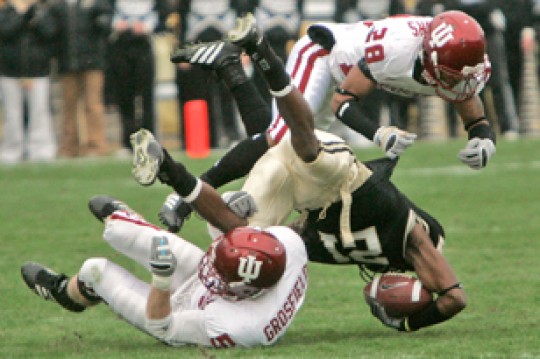IU Health and Wellness: tips about concussion recovery, politics and intimacy.
IU Health and Wellness: tips about concussion recovery, politics and intimacy
IU Health and Wellness for February discusses the following topics:
> New research involving return-to-play decisions after a concussion.
New study cautions against over-reliance on computer testing when deciding to put athletes back in play
A new study by researchers at Indiana University-Purdue University Columbus and Pace University is critical of the widespread use of computerized neuropsychological tests (CNT) in decisions regarding when athletes can return to play after suffering a concussion.

“Our knowledge of the effects of concussions continues to evolve,” said Thomas Redick, assistant professor of psychology at IUPUC. “We should continue to ask ourselves what the best practices are when dealing with a brain injury, which is what a concussion is.”
The use of computer tests to measure an athlete’s thinking ability before and after concussion has become commonplace at all levels of contact sport, typically beginning in high school, and the post-trauma test result is one part in determining when an athlete can get back in the game. The dangers of returning to play prematurely can be grave — including the rare cases that lead to a degeneration of brain tissue (chronic traumatic encephalopathy) and even death. Yet the ability to determine the severity of a head trauma and stage of recovery is very difficult.
“We should note that no ‘gold standard’ exists for concussion diagnosis and management,” the researchers wrote. “Sports medicine practitioners still lack simple, reliable and affordable techniques to confidently address these issues. Although experienced first responders can accomplish a clinical diagnosis in most instances of suspected concussion, concerns related to return of play and whether or not to continue specific sport participation are not resolved by current CNT.”
The study, published online in the Journal of Clinical and Experimental Neuropsychology, reviewed previously published research articles involving Immediate Post-concussion Assessment and Cognitive Testing (ImPACT), one of several CNT in use today and considered the most scientifically validated computerized concussion evaluation system. The researchers cautioned against overreliance on CNT in return-to-play decisions for the following reasons:
- The tests, which are often measured in the preseason as a baseline and then again after a concussion, may not possess adequate levels of reliability to use in the management of individual athletes. This could lead injured athletes to return to play before being fully recovered. In contrast, low test reliability could keep athletes out of further contests longer than necessary, which can have adverse effects for the team and the athlete.
- The tests do not measure other important aspects of brain function, such as functional and metabolic impairments of the brain. Tests using other techniques have revealed abnormal brain function for up to 28 days after the injury. Studies have indicated that ImPACT cognitive performance typically normalizes within three weeks of the injury. “Postconcussion cognition recovery appears to occur relatively quickly, but this does not equate to rapid healing of an injured brain,” the researchers wrote in the research article.
- The only treatment for concussions is physical and cognitive rest. Taking a 20-minute detailed test in order to confirm a clinically apparent concussion could harm recovery.
- Future research with ImPACT and other CNT is warranted to provide the most accurate and reliable information possible about the cognitive state of athletes after suffering a concussion.
The journal article will be available online for about a month beginning Feb. 2.
“Clinical utility of ImPACT assessment for postconcussion return-to-play counseling: Psychometric issues,” will appear in the Journal of Clinical and Experimental Neuropsychology in mid-February. The co-author is Lester B. Mayers, M.D., Division of Sports Medicine, Pace University.
###
> Cupid’s political inclinations
Even Cupid is into politics?
New study findings suggest singles’ voting habits reflect their views on sex and love. The second annual Singles in America study, sponsored by Match.com, investigated a variety of topics related to the quest for companionship — including how politics are impacting people’s lives.
 Justin Garcia/ Courtesy of Indiana University
Justin Garcia/ Courtesy of Indiana University
“Political views can color our perspective on the world and impact what is important — whether it be financially or romantically,” said evolutionary biologist Justin Garcia, a co-investigator of the study and fellow at The Kinsey Institute at Indiana University. “It’s not surprising that political views impact attitudes and behaviors, including dating, but how politics relate to these important aspects of our adult lives is fascinating to uncover.”
The study investigates dating habits, behaviors, interests and lifestyles of this formidable segment of the population. Single adults represent an estimated one-third of the U.S. population, yet researchers say little data on this group had been available until the Match.com study. The study, based on the attitudes and behaviors taken from a representative sample of more than 5,000 U.S. singles ages 21 to 65, included these findings.
- Among those singles who have been previously married, 40 percent of conservative Republicans were “very satisfied” with sex while they’re married — significantly more than other political groups. But, conservative Republicans also had the least amount of sexual activity in the past 12 months.
- Fidelity is regarded as a more important quality in the U.S. president than in a partner. In the study, 62 percent of men and 80 percent of women say sexual fidelity in a relationship is a “must have.” But almost 9 out of 10 respondents reported they believe there are “no acceptable excuses” for infidelity in a political candidate (87 percent of men and 91 percent of women).
- Republican and Democratic singles seek dramatically different traits in a partner. Liberal Democrats are more likely to search for someone with a sense of humor, a similar lifestyle to their own and a sense of independence, and someone they consider to be their equal. Republicans reported searching for someone with the same background and political party as their own who is interested in marriage.
Findings from the 2012 report address a range of topics, including the economy, men’s views of working women, and the desires of people 60 and older and of single gays and lesbians. More findings are available here. Singles in America was funded by Match.com and conducted by MarketTools in association with Garcia; biological anthropologist Helen Fisher; and the Institute for Evolutionary Studies at Binghamton University.
###
> Getting back into the dating game — science and intimacy
Getting back into the dating game — science and intimacy
Getting back into the dating game can be a daunting task at any age — especially after many years of being married. Whether the marriage ended in a hurtful divorce or left a spouse mourning the loss of a loved one, a person might be unsure of what to expect in a new relationship, particularly when it comes to sex.

Photo by Nic Snell
Debby Herbenick, co-director of the Center for Sexual Health Promotion at Indiana University, offers some tips for those newly single men and women who are looking to revive their sex life:
- Sex has changed — but not dramatically. Data from the National Survey of Sexual Health and Behavior, for which Herbenick was a lead researcher, demonstrate that sex in America has changed, to some extent, over the past 20 years. Slightly more Americans report having had oral sex and significantly more American women and men (as many as 40 percent to 45 percent in some age groups) report having had anal sex. That said, many people appear to engage in anal sex only rarely. “The best news about sex is that it remains incredibly diverse with plenty of room to make of it what you and your partner want and to leave out the parts you don’t,” Herbenick said.
- Sex may feel different than it did before. Very often, people who are returning to sex after a period of time without it are surprised to note that in some ways it feels like before (“just like riding a bike”) and in other ways it can feel very different. Starting over with someone new means having to tell and show them what you like and learning from them what they like, too. That can feel daunting for some and invigorating for others. “There are emotional aspects to starting again, too — facing your changed (and changing) body, reconnecting with someone, letting go, and showing your partner a private side of yourself,” Herbenick said. As for the physical aspects, genitals may feel and work differently than one remembers, depending on one’s health and age and all sorts of other factors. With menopause can come vaginal dryness (vaginal moisturizers and lubricant can help with this) and, for men, erectile difficulties can become more common (reading “The New Male Sexuality” can be helpful, as can sex therapy and, for some, prescription medications).
- Safer sex isn’t only for teenagers. Data from the National Survey of Sexual Health and Behavior clearly show that teenagers are among the best and most frequent condom users. Adults could take a lesson from teenagers and use condoms more often with new and casual partners, partners whose sexually transmissible infection or HIV status they don’t know, or for birth control. In the study, 84 percent of 14- to 17-year-old males and 89 percent of 14- to 17-year-old females reported using a condom during their most recent sex act with a casual partner. However, these numbers were drastically lower among older adults, with about one-fifth to one-third (depending on the age group) reporting condom use with a casual partner.
- Condoms have changed. There are more pleasure-focused condom choices than ever before: ribbed, studded, flavored, condoms with warming lubricant, better-fitting condoms for greater comfort and sensation, condoms that come with vibrating condom rings, and condoms that — in independent tests conducted at IU — some men have said felt so natural that they wondered if the condom was even still on (it was). Further, National Survey of Sexual Health and Behavior data show that Americans who used condoms during their most recent sexual encounter tended to rate the sex as just as arousing and pleasurable as Americans who did not use a condom during their most recent sexual encounter.
- Toys. Once largely relegated to adult bookstores frequented almost entirely by men, vibrators and other sex toys are now widely available on the Internet, through women’s in-home sex toy parties, and in the condom aisle of many drug stores and local chains. Vibrators have also been in the hands of 53 percent of American women and nearly half of American men, according to a 2009 study by the Center for Sexual Health Promotion published in the Journal of Sexual Medicine. “They’ve also been linked to positive sexual function for women and men — plus, as we found in our research published in the Journal of Sex and Marital Therapy, most Americans feel that they contribute to healthy relationships and help make it easier for women to experience orgasm,” Herbenick said.
- Lubricant is about pleasure, not just problem solving. Just as sex toys were once mostly in sketchy parts of town, lubricant was once mostly found in doctor’s offices — or in your grandmother’s bathroom drawer. Today, lubricants are commonly used for foreplay, sex play, and making intercourse more comfortable, pleasurable and exciting for couples of all ages. In a study of more than 2,400 women, Herbenick and her colleagues found that when women used lubricant during vaginal sex, anal sex or masturbation, they tended to rate it as more pleasurable and satisfying than when they didn’t use lubricant. “That doesn’t mean that you should use lubricant every time you have sex (though you can if you want to),” Herbenick said. “But it’s probably a good idea to have a bottle of water-based lubricant on your nightstand just in case you feel like adding some to your sex play.”
Herbenick is co-director of the Center for Sexual Health Promotion at the IU School of Health, Physical Education and Recreation, a sexual health educator at The Kinsey Institute and a widely read sex columnist. She is the author of “Because It Feels Good,” “Read My Lips” and “The I Love You More Book.” Her newest book, “Great in Bed,” is out this month.
###
> About Indiana University.
INDIANA UNIVERSITY is a major multi-campus public research institution, grounded in the liberal arts and sciences, and a world leader in professional, medical, and technological education. Indiana University’s mission is to provide broad access to undergraduate, graduate, and continuing education for students throughout Indiana, the United States, and the world, as well as outstanding academic and cultural programs and student services.
Indiana University seeks to create dynamic partnerships with the state and local communities in economic, social, and cultural development and to offer leadership in creative solutions for 21st century problems.
Indiana University strives to achieve full diversity, and to maintain friendly, collegial, and humane environments, with a strong commitment to academic freedom.
INDIANA UNIVERSITY HAS EIGHT CAMPUSES, including core campuses in Bloomington and Indianapolis, and regional campuses in Fort Wayne, Gary, Kokomo, New Albany, Richmond, and South Bend.
More at Indiana University &
* The above story is adapted from materials provided by Indiana University.




















